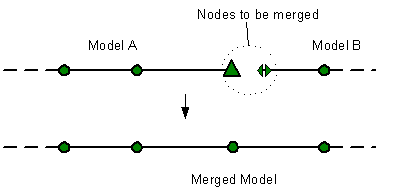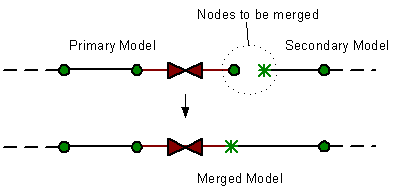Joining models
Join Models allows pairs of model objects to be combined into single merged objects.
This functionality allows different users to model separate parts of the system as different networks at the same time. The networks and the items associated with the networks can then be merged into a single model.
The model objects that can be merged are:
- Networks
- Controls
- Demand Diagrams
- Electricity Tariffs
- Demand Scalings
- UPC Scenarios
- Alternative Demands
- Runs
(If Run objects are selected for merging, items associated with the Run will automatically be selected for merging also.)
Merging Objects
To merge objects:
- Select the Join Models option from the Tools menu. The Join Models dialog will be displayed.
- On the Join Models dialog:
- Drag and drop source objects to be merged into the Primary Objects and Secondary Objects selection boxes, or use the Browse button to browse for an object.
- Merged Object names and locations will be set by default. These can be changed if required
- Select the destination for the log report from the Output section
- Click the Join button to carry out the merge process.
Each pair of Primary and Secondary objects will be merged into a single object, which will be created in the location defined in the Join Models dialog.
Merging Rules
Details on merging rules are given below. General rules apply to all object types that can be merged. Exceptions to the general rules are detailed in the subsequent sections:
General Merging Rules
The following rules are applied to all items when carrying out the merging process:
- Secondary Objects are added to Primary objects. If a conflict in data values occurs, the values for the primary object will take precedence and a warning message will be added to the log. For example: Node 'A' is of type Fixed Head in the Primary Network, but of type Well in the Secondary Network. The Fixed Head node in the Primary Network will take precedence and will be included in the merged network
- The same object may be selected as the Primary and Secondary Object. In this case the object will be copied to the Merged Object location specified in the Join Models dialog.
- A Primary Object only or a Secondary Object only may be selected. In this case the object will be copied to the Merged Object location specified in the Join Models dialog.
Network Merging Rules
In general, when there is conflicting data between objects in the primary and secondary network, the primary object will take precedence. The following exceptions are applied when merging networks:
Merging a Fixed Head Node with a Transfer Node
A node present in both the primary and secondary network as a Fixed Head node in one network and a Transfer Node in the other, will be merged into a basic node with no control.
This is to allow for cases in which each network contains a simplified representation of the head / flow from the other network.

Merging Two Transfer Nodes
A node present in both the primary and secondary network as a Transfer Node, will be merged into a basic node with no control.
This is to allow for cases in which each network contains a simplified representation of the flow into / out of the other network.
Merging Nodes with Directly Allocated Demand
If a node in one (and only one) of the models has directly-allocated demand, this demand will be retained in the joined model. If both models have directly-allocated demand for the node, then only the demand from the primary model will be retained and a warning will be displayed in the log.
This is to allow for cases in which connecting nodes may be on one side of a closed valve with demand allocated to the node in one model only.

Merging Nodes with Land Use Demands
If a node in one (and only one) of the models has Land Use demand allocated to it, this demand will be retained in the joined model. If both models have Land Use demand allocated to the node, then only the demand from the primary model will be retained and a warning will be displayed in the log.
Control Data Merging Rules
In general, when there is conflicting data between objects in the primary and secondary Control, the primary object will take precedence. The following exceptions are applied when merging Controls:
- Global UPC Scripts from the primary and secondary Control Data items will be concatenated when the status of the Disable UPC option, (displayed on the Global UPC Script View), is the same in both control items. If the status of the Disable UPC option is not the same in both control items, only the script which is not disabled is copied to the joined control.
UPC Scenario Merging Rules
In general, when there is conflicting data between regulator dependents in the primary and secondary UPC Scenario, the primary object will take precedence. The following exceptions are applied when merging UPC Scenarios:
- Global items in the UPC Scenario will be concatenated
